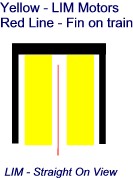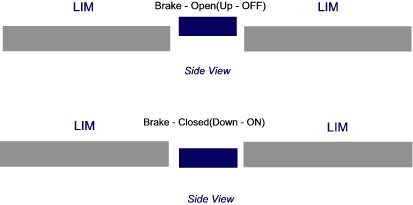 |
LIMs or linear
induction motor: Are electro magnet motors.
In order to power Wicked Twister, a
34,000 volt electrical cable is being run from Sandusky exclusive for
Wicked Twister.
Figure 1

The
brakes on Wicked Twister are similar to Millennium Force's brakes. The
brakes are located between the LIMs, and when open are above the path of
the copper fin located on the train. When activated, the brake is
lowered into the path of the copper fin to slow the train down. By using rare earth magnets, the brakes
form a magnetic field in which the cooper fin on the train passes
though, which slows down the train to a smooth and final stop.
Currently Millennium Force, Mantis, and Iron Dragon are the only roller coasters at
Cedar Point with "safety gates".
|
 |
"How Wicked
Twister Works"
Wicked
Twister, the world's tallest and fastest Impulse roller coaster, will
open at Cedar Point in May 2002, as one "brainy" ride. Perhaps
it will be the most technical ride at the Po!nt, but it will take more
power than anything else. This article will try to explain to you, how
Wicked Twister will operate.
First off, if you have no idea what this whole "Wicked
Twister" thing is, I recommend you swing on over to Wicked
Twister's ride page, which will give you the low down on
what the ride will be along with all the stats you can dig.
Wicked Twister, uses linear induction motor (LIMs), to send
thrill
seekers up and down it's two tower. LIMs are located throughout the
station/launch area of the ride. When guests have entered the ride and
it gets a "ready" from the computer, the park attendant then
hits a "fire" button that will active the LIMs. Upon
activation, the LIM use electric charges to move the train down the track. By
generating a positive and negative electro-magnetic field, the copper fins on react
and move down the track. Figure 1 shows the fin on the train as it
passes through the LIMs. As soon as the train heads up the tower, it is
coasting with no help from the LIMs. When gravity takes over, the train
begins to fall back to earth and enters the LIMs. This time, since the
train is entering the LIMs at 60+ mph instead of 0 mph like on the
first launch, the train will pick up even more speed as it passes
backwards through the LIMs. The as the ride continues, the trains gets
launched foreword and backwards several more times.
As the train makes the final launch through the LIMs and up the foreword
tower, the amount of electric power in the LIMs is decreased, so the the
train does not pick up speed but is given a push through the LIMs. Figure
2.1 shows the position of the brakes while the final launch is taking
place. As the train clears the LIMs and heads up the final tower, the
brakes are activated and come down as shown in figure 2.2.

Figure 2.1
Figure
2.2
Since Wicket Twister will be passing through its station at high speeds,
it is necessary to keep people from coming in the path of the train. At
this time, I am unsure of how Cedar Point is going to create a solution.
Here are some good guesses:
-
Laser
Eye: By having laser "eyes" at each end of the station,
they could detect when someone enters the ride's path.
-
Sensitive
Floor: Having sensors in the floor under the rides path, that could
tell whether not anything is in the ride's path.
-
Safety
Gates: A good assumption is that the ride will have gates the block
the trains path from riders, the gates would be used in ADDITION to
the laser eye and/or sensitive floor.
According
to the permits filed with the city of Sandusky, the ride will have
"six" operating control panels. A good guess would be that each in
employees has to be at one of these, pushing a button, the would allow
the ride to move about. If they saw a problem they could let up on
their button, and the ride would come to a emergency stop. For a emergency
stop, the LIMs would "de-power" and the brakes would
be activated and would move into the "on" position (figure
2.2).
|
|


![]()


